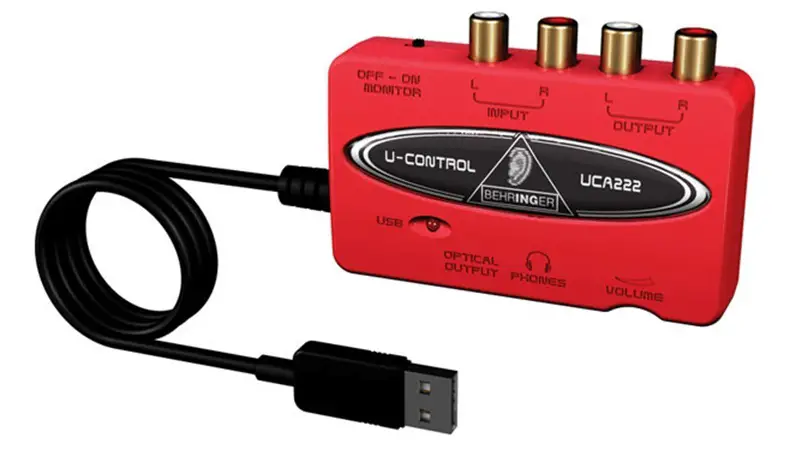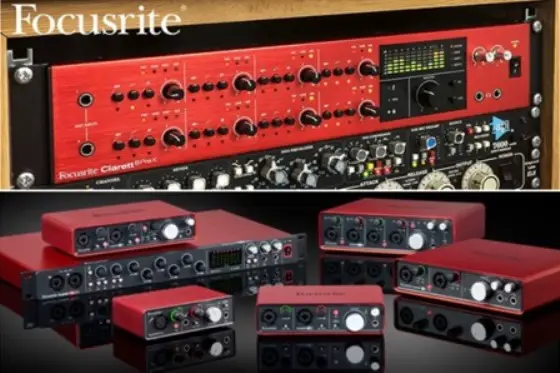Every computer has a sound card built in it for audio purposes, but you need to bear in mind that this is not designed for any audio or music production. That is the reason it is best to invest a decent audio interface.
An audio interface is a professional sound-card that you will need if you want to do serious audio work on your computer. It provides you with all the inputs and output (audio / midi connections) you need for your work and is an important part of any studio.
Features on a professional soundcard include:
- Low latency sound recording and playback
- Available as external rack-mountable units which can be connected using USB/Firewire
- Large number of input and output connectors
- Hardware support for multiple input and output sound channels
- Higher sampling rates compared to a consumer sound-card
- Multi-channel data recording and real-time audio mixer and processor
You will need a soundcard with sufficient inputs/outputs to connect most of your gear. In general, the following are some of the instruments that you will need to connect to your soundcard.
- Microphones
- Control surface / mixer
- Audio speakers / Monitors
- Computer
A simple audio interface costing hundred bucks will be good enough for a simple bedroom studio, where you just need outputs for your studio monitors. However, for more demanding scenarios, you will need an audio interface with several INs/OUTs, and it can easily cost over a thousand dollars.
Audio Interface Performance Factors
Soundcards (audio interfaces) have AD/DA converters built into them. They convert Analog to Digital, to get the sound into the computer that you can process with effects. And, they convert the Digital to Analog, to get the sound from the computer to the monitor.
These converters are of better quality in an audio interface (compared to a computer’s built-in sound-card).
The best digital audio interfaces will have the shortest latency time. Latency is the time it takes the AD/DA converter to get the sound from the device to the computer, and then back to the monitor.
Some interfaces provide dedicated buttons and knobs that provides access to several functions right at your fingertips, even without touching the menu. You can press a button to select the talkback mic, turn the dedicated knob to hear more of the input signal, press a button to switch monitors, turn the volume level for headphones, etc.
You may also need external Preamps to raise the level of your mic’s. Though most of the soundcards have built-in preamps, only the more expensive ones have really good preamps.
Types of Interface Connectors in Audio Interfaces
The four common types of audio interfaces, depending on the way its connected (cable options commonly used) to the computer or other devices:
- USB: Commonly available on the cheaper home studio interfaces, slowest data transfer rate of all the options available.
- Firewire – More expensive, offers faster transfer rate (but many prefer the Thunderbolt nowadays).
- Thunderbolt – More popular today and is commonly seen in most new semi-pro interfaces, its faster than USB or Firewire.
Best Desktop Interfaces
USB Audio Interfaces
USB audio interfaces are easy to connect, are portable, come with useful functions and offer very less (almost zero) latency.
Apogee ONE
The Apogee ONE is an all-inclusive interface, packing an XLR input with pro-quality mic preamp, 1/4″ input for your guitar or bass, Apogee A/D converters, and even an internal microphone for capturing quick demos. Use this pocket interface to create polished recordings on your iPhone, iPad, MacBook, and more.
Harness Apogee’s pristine A/D for your iPad or Mac. This ONE lets you record a single XLR microphone, or the 1/4″ input and internal mic in 2-channel mode.
The USB audio interface ships with a breakout cable with an XLR Mic input and 1/4-inch Instrument input, microphone stand clip, USB cable, 30-pin iOS cable, and Lightning iOS cable.
Focusrite Scarlett 2i4 USB Audio Interface
Focusrite Scarlett 2i4 is a versatile USB-powered audio interface. It comes with two XLR-1/4″ mic preamps, 4 analog outputs and MIDI I/O, the Scarlett 2i4 is the perfect portable USB-powered audio interface for DJs and producers.
Buy on zZounds
Behringer UCA222 USB Audio Interface
 The Behringer UCA222 is an excellent RCA to USB Audio Interface for quick recording and if you’re looking for a cheap interface for your home studio. It’s self powered, and has both 1/8″ and RCA outputs. It easily transfers audio to your computer and comes bundled with several production tools and audio-editing software.
The Behringer UCA222 is an excellent RCA to USB Audio Interface for quick recording and if you’re looking for a cheap interface for your home studio. It’s self powered, and has both 1/8″ and RCA outputs. It easily transfers audio to your computer and comes bundled with several production tools and audio-editing software.
Presonus Audio Interfaces
 The AudioBox USB is a USB bus-powered audio recording interface featuring 2 microphone/instrument inputs with 48V phantom power, 2 balanced TRS outputs, and MIDI in/out. It boasts 2 PreSonus mic preamps and Studio One Artist DAW software. Capture your ideas wherever you go.
The AudioBox USB is a USB bus-powered audio recording interface featuring 2 microphone/instrument inputs with 48V phantom power, 2 balanced TRS outputs, and MIDI in/out. It boasts 2 PreSonus mic preamps and Studio One Artist DAW software. Capture your ideas wherever you go.
Focusrite Audio Interfaces

Focusrite is a leading manufacturer of audio interfaces and produces a wide range of interfaces and mic pres.
Focusrite USB Audio Devices (Scarlett Series)
Focusrite Scarlett USB interfaces are quite popular for these purposes because they are more compact, affordable and plugs into USB. These also feature excellent preamps.
The higher models come with two Focusrite mic preamps, offer effects such as Compression, EQ, Reverb and Gate plug-ins, making it the complete professional recording package for musicians
Focusrite Thunderbolt Interfaces (Clarett Series)
The Clarett series of audio interfaces feature transformer-modeled preamps, and have almost no interface latency. These come with several Ins and Outs, including headphone output. Suitable for home musicians, professional studio engineers and even music producers.
Useful Read/Links
When should you use a midi-interface
Interfaces for iOS devices such as iPad
KeytarHQ editorial team includes musicians who write and review products for pianists, keyboardists, guitarists & other musicians. KeytarHQ is the best online resource for information on keyboards, pianos, synths, keytars, guitars and music gear for musicians of all abilities, ages and interests.



Leave a Reply